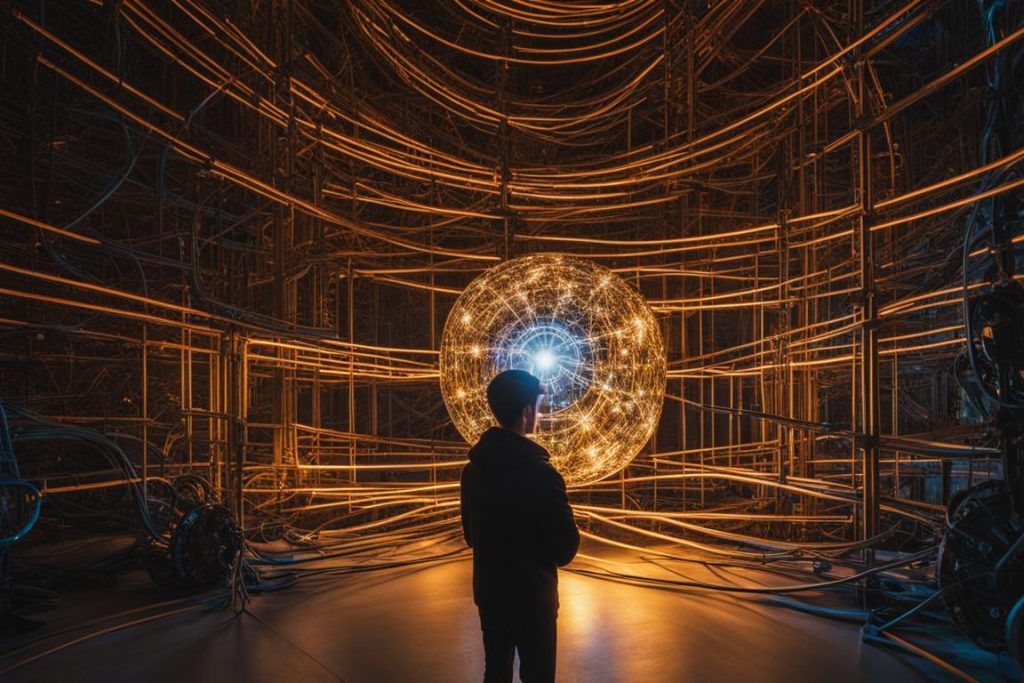Dreams are mysterious and fascinating glimpses into our subconscious minds. One particularly haunting and enigmatic experience is dreaming of someone standing beside your bed. These dreams often leave a lasting impression, eliciting a strong sense of presence and connection. But what do these dreams truly mean? In this article, I will explore the symbolism of bedside specter dreams, delve into the significance of dream interpretation, and discuss the emerging fields of dream engineering and dream incubation.
Someone Standing Next to Your Bed
- Dreams of someone standing beside your bed can be vivid and emotionally charged experiences.
- Freud believed that dreams could convey important messages and emotions.
- Dream interpretation is a complex field that offers insights into our subconscious minds.
- Dream incubation and dream engineering explore intentional methods of shaping and controlling dreams.
- Dreams may serve various functions, such as processing emotions and problem-solving.
The Significance of Dream Interpretation
Dreams have fascinated and intrigued humanity for centuries. They hold a mysterious and captivating allure, enticing us to explore their meanings and unlock the secrets of our subconscious minds. While some may dismiss dreams as mere random brain activity, many believe that they hold deeper significance and can offer valuable insights into our emotions, desires, and fears. This is where dream interpretation comes into play, as a way to decipher and understand the hidden messages within our dreams.
In his seminal work, “The Interpretation of Dreams,” Sigmund Freud delves into the concept of dreams as wish-fulfillment, suggesting that they are a means for our unconscious desires and emotions to manifest themselves. According to Freud, dreams are symbolic representations of our deepest wishes and fears, providing a window into the inner workings of our minds. By unraveling these symbols and deciphering their meanings, we can gain a better understanding of ourselves and our subconscious motivations.
Dream interpretation is a multifaceted field, encompassing various theories and approaches. Some interpret dreams through a psychoanalytic lens, exploring the hidden meanings behind their symbols and imagery. Others take a more spiritual or metaphysical approach, viewing dreams as divine messages or prophetic visions. Regardless of the method used, the overarching goal of dream interpretation is to uncover the underlying messages and emotions contained within our dreams, offering us valuable insights into our inner selves.
The Power of Dream Interpretation
Dream interpretation holds the power to illuminate the hidden corners of our minds and provide us with a deeper understanding of ourselves. It allows us to tap into our subconscious thoughts, desires, and fears, bringing them to light and giving us the opportunity to confront and address them. By exploring the meanings behind our dreams, we can gain valuable self-insight, enhance personal growth, and make positive changes in our lives.
However, it is important to note that dream interpretation is a highly individual process. While certain symbols and imagery may hold common meanings, their interpretation can vary greatly from person to person. It is crucial to consider personal experiences, cultural influences, and individual beliefs when analyzing dreams. Consulting with a professional dream analyst or psychologist can provide guidance and additional perspectives on the meanings of dreams, helping us navigate the intricate and fascinating terrain of our subconscious minds.
Exploring Dream Incubation
Dream incubation is an intriguing technique that allows individuals to have more control over the content of their dreams. Through the use of innovative technologies like the Dormio device, dreamers can shape and guide their dreaming experiences. This process involves intentional thoughts and prompts that influence the direction and themes of the dreamscape. Dream incubation opens up a world of possibilities for exploring our subconscious minds and gaining deeper insights into our desires and emotions.
The Dormio device, developed by researchers at the MIT Media Lab, is at the forefront of dream incubation technology. Using voice recordings and prompts, it engages with dreamers during the hypnagogic stage of sleep, which is the transition between wakefulness and sleep. By focusing on specific thoughts, such as envisioning trees, the device helps guide the dreamer’s mind towards dream scenarios associated with the chosen theme.
This intentional shaping of dreams can be a powerful tool for self-exploration and personal growth. By actively participating in the creation of dream narratives, dream incubation allows us to explore our deepest desires, fears, and emotions in a safe and controlled environment. It can also be a means of problem-solving, as dreams often provide unique perspectives and creative solutions to real-life challenges.
Dream Engineering: Manipulating Dreams for Lucid Dreaming
Dream engineering is an exciting field that explores the possibilities of manipulating dreams for a more controlled and intentional dreaming experience. Researchers are delving into the intricacies of dreaming and developing techniques to alter or shape the content of dreams. While studies have explored various methods, one innovative approach is the use of the Dormio device.

The Dormio device, developed by researchers at the MIT Media Lab, aims to facilitate dream incubation and lucid dreaming. This wearable device uses voice recordings and prompts to influence the dreamer’s thoughts during the hypnagogic stage of sleep. By focusing on specific topics or imagery, dreamers can potentially enhance their ability to control and shape their dreams.
Through dream engineering, individuals may have the opportunity to explore imaginative landscapes, confront fears, or even practice new skills. Lucid dreaming, a state in which the dreamer is aware they are dreaming, can provide a platform for creative expression and self-discovery. The ability to manipulate dreams opens up a world of possibilities for personal growth and exploration of the subconscious mind.
Advancements in Dream Engineering
The field of dream engineering is rapidly evolving, with researchers and inventors continuously seeking new methods to enhance dream manipulation. Alongside the Dormio device, studies have explored the use of electrical stimulation to induce lucid dreaming. Future advancements may involve a deeper understanding of the brain mechanisms involved in dreaming and the development of more sophisticated technologies.
While dream engineering offers exciting prospects, it also poses ethical questions and potential risks. Manipulating dreams raises concerns about the invasion of privacy, impact on mental health, and the blurring of boundaries between waking and dreaming states. As the field progresses, it is essential for researchers to consider the ethical implications and ensure the safety and well-being of participants.
Ultimately, dream engineering holds the promise of unlocking the full potential of our dreams. Whether it’s for personal growth, creative expression, or simply for the joy of exploration, the ability to manipulate dreams offers a fascinating glimpse into the depths of human consciousness.
The Purpose of Dreams
Dreams have long fascinated and intrigued us, with their enigmatic qualities and mysterious symbolism. While the purpose of dreams is still a subject of debate among scientists and researchers, several theories suggest that dreams serve important functions in our lives.
Functions of Dreams
One of the key functions of dreams is the processing of emotions. Dreams provide a safe space for us to explore and work through our feelings, allowing us to process and make sense of complex emotions that we may not fully understand in our waking lives.
Additionally, dreams are believed to play a role in memory consolidation. During sleep, our brains are actively processing the events and information of the day, solidifying memories and helping us retain important knowledge. Dreams may serve as a mechanism for organizing and integrating these memories into our long-term storage.
Furthermore, dreams have been linked to problem-solving and creativity. Many groundbreaking discoveries and inventions have been attributed to insights gained in dreams. By tapping into our subconscious mind, dreams can unlock new perspectives and inspire innovative thinking.
| Purpose of Dreams | Functions |
|---|---|
| Emotional processing | Provides a safe space to work through complex emotions |
| Memory consolidation | Aids in organizing and integrating memories |
| Problem-solving and creativity | Inspires innovative thinking and new perspectives |
“Dreams are the touchstones of our characters.” – Henry David Thoreau
While the precise purpose of dreams may vary from person to person, these broad functions provide a framework for understanding the importance of dreams in our lives. Whether they serve as a means of emotional healing, a tool for memory consolidation, or a wellspring of creativity, dreams offer us a unique and valuable window into the workings of our subconscious mind.
As research and understanding in the field of dream studies continue to advance, we may gain further insights into the purpose and significance of dreams. Exploring the depths of our dreamscape can lead to profound personal discoveries and a deeper understanding of ourselves.

In summary, dream perception encompasses the vividness and realism of dreams, the symbolism and imagery they present, and their elusive nature. Dreams can transport us to extraordinary realms, blurring the line between reality and fantasy. Whether they offer glimpses into our subconscious minds or provide a deeper connection to something greater, dreams continue to captivate and intrigue us.
Unraveling the Symbolism of Bedside Specter Dreams
Dreams involving someone standing beside the bed can be both intriguing and mysterious, often leaving the dreamer with a lingering sense of curiosity and wonder. These dreams are rich with symbolism and can hold deep meaning for the individual experiencing them. Understanding the symbolism within bedside specter dreams requires delving into the layers of the subconscious mind and exploring the personal significance they hold.
In these dreams, the presence of someone standing beside the bed may represent unresolved emotions or hidden desires. It can serve as a reflection of the dreamer’s need for guidance or their longing for connection. The figure standing next to the bed may also symbolize vulnerability or evoke feelings of fear. Each dreamer’s experience is unique, and unraveling the symbolism of these dreams requires personal introspection and reflection.
As I delved into my own dreams of someone standing beside my bed, I found that they held a variety of symbolic meanings. At times, the presence of another person represented a part of myself that I had neglected or ignored. Other times, it served as a reminder of unfinished business or unresolved conflicts in my life. These dreams acted as a mirror, reflecting my inner thoughts and emotions that I may have been unaware of in my waking life.
Exploring the symbolism within bedside specter dreams can lead to profound self-discovery and understanding. It invites us to confront our deepest fears, desires, and vulnerabilities, providing a gateway to personal growth and transformation.
It is important to note that the symbolism in these dreams is highly subjective and can vary from person to person. While there may be common themes and interpretations, each dreamer will have their own unique experience and understanding. The key to unraveling the symbolism lies in exploring the personal significance and emotional resonance of the dream.
Exploring the Symbolism
| Symbol | Meaning |
|---|---|
| Presence of another person | Represent unresolved emotions, hidden desires, or the need for guidance |
| Feeling of vulnerability | Reflect fear or the need for protection |
| Longing for connection | Indicate the desire for emotional intimacy or a sense of belonging |
Exploring the symbolism within bedside specter dreams can lead to profound self-discovery and understanding. It invites us to confront our deepest fears, desires, and vulnerabilities, providing a gateway to personal growth and transformation.
The Role of Memory in Dream Recall
Remembering dreams can be a fascinating but challenging endeavor. The elusive nature of dream memory often leaves us grasping at fragments upon awakening. Why is it that some dreams fade away like a wisp of smoke, while others linger in our consciousness for hours or even days? To understand the role of memory in dream recall, we must delve into the unique characteristics of dream memory and the factors that influence its retention.
One of the primary factors that affect dream recall is the stage of sleep in which dreams occur. Dreams primarily happen during the rapid eye movement (REM) stage, which is characterized by heightened brain activity and vivid dream experiences. However, dream memories can easily slip away as we transition into wakefulness. The transition from the dream state to wakefulness involves a shift in brain activity and a loss of the neurochemical conditions that support dream memory consolidation.
Additionally, cognitive processes play a significant role in dream recall. Upon awakening, the brain must navigate through various cognitive tasks, such as orienting to the present moment, organizing thoughts, and encoding new memories. These processes can interfere with the retrieval of dream memories, leading to their rapid fading or even complete forgetting.
Dream recall is a complex interplay between the stages of sleep, brain activity, and cognitive processes. While some dreams may leave a lasting impression, others may slip away into the recesses of our mind. Enhancing dream recall requires awareness, practice, and perhaps even the development of strategies or techniques that promote memory consolidation and retrieval. Exploring the fascinating realm of dream recall can offer new insights into the workings of our subconscious minds and the mysteries of the dream world.
Limitations And Future Directions
As with any area of scientific research, the study of dreams faces its own set of limitations. One significant challenge is the subjective nature of dream reporting. Dreams are highly personal experiences, and individuals may have difficulty accurately recalling and describing their dreams upon waking. This subjectivity can make it challenging for researchers to gather reliable and consistent data for analysis.
Another limitation is the complexity of studying the brain during sleep. While advancements in neuroimaging techniques have allowed researchers to gain insights into brain activity during wakefulness, studying the brain during sleep poses unique challenges. The various stages of sleep, the fluctuating levels of brain activity, and the different types of dreams make it difficult to capture and interpret data with precision.
Despite these limitations, the field of dream research continues to evolve, driven by curiosity and advancements in technology. The future of dream studies holds promise in several areas. Innovative data collection methods, such as wearable devices and mobile apps, may provide new opportunities for capturing dream experiences and analyzing large datasets. Additionally, interdisciplinary collaborations between neuroscientists, psychologists, and computer scientists can offer fresh perspectives and approaches to understanding the complexities of dreaming.
| Limitations of Dream Research | Future of Dream Studies |
|---|---|
| Subjective nature of dream reporting | Innovative data collection methods |
| Complexity of studying the brain during sleep | Interdisciplinary collaborations |
| Advancements in neuroimaging techniques |
“Dream research faces challenges in gathering reliable and consistent data due to the subjective nature of dream reporting.”
“The future of dream studies may involve innovative data collection methods and interdisciplinary collaborations.”
Understanding Dreams from New Perspectives
The limitations in dream research also open the door for experimentation and exploration of new perspectives. Researchers can incorporate qualitative research methods to delve deeper into the individual experiences and meanings associated with dreams. This approach can provide valuable insights into the rich and personal nature of dream states.
Advancements in technology, such as virtual reality and artificial intelligence, may also play a role in the future of dream studies. These technologies can create immersive and controlled dream environments, allowing researchers to manipulate variables and observe dream experiences in a more controlled manner.
While many questions and challenges remain, the future of dream studies holds the potential for groundbreaking discoveries and a deeper understanding of the human mind and consciousness. Through continued research and exploration, we may uncover the true nature and purpose of dreams, unlocking their full potential for personal growth, therapy, and creative inspiration.
Personal Insights into Dream Incubation
During my exploration of dream incubation, I had the opportunity to use the Dormio device, and it was an intriguing and transformative experience. As I wore the device and followed the prompts to think about trees, I felt a sense of anticipation as I entered the hypnagogic state. The visual imagery that unfolded before me was vivid and lifelike, as if I had stepped into another world.
One particular dream stood out to me. I found myself walking through a dense forest, surrounded by towering trees that seemed to whisper secrets. As I touched the bark of one tree, I felt a surge of connection and understanding. It was as if I had tapped into the wisdom of nature itself. The experience left me with a profound sense of awe and reverence.
“Dream incubation allowed me to shape the content of my dreams and tap into the depths of my subconscious mind. It opened up a new realm of self-discovery and introspection.”
Using the Dormio device and engaging in dream incubation has given me a glimpse into the potential of dream engineering. It has raised thought-provoking questions about the purpose and nature of dreams. Are they simply random manifestations of our subconscious thoughts, or do they hold deeper meaning? Can we consciously shape our dreams to gain insights and guidance?
The Power of Dream Incubation
My personal experience with dream incubation has shown me the power of tapping into the rich inner world of dreams. It has broadened my understanding of the intricate connections between our conscious and unconscious minds. Dream incubation offers a unique opportunity to explore and harness the potential of our dreams for personal growth, creativity, and self-exploration.
As further research and advancements in dream engineering unfold, I believe we will continue to unravel the mysteries of the dream realm. Dream incubation holds the promise of unlocking new avenues for self-discovery and expanding our understanding of the human mind. The exploration of dreams and their potential significance is an ongoing journey, one that invites us to explore the depths of our own consciousness.
The Intersection of Science and Spirituality
When it comes to understanding dreams, there is a fascinating intersection between science and spirituality. While scientific research delves into the neurological and psychological aspects of dreams, spirituality offers alternative perspectives on their meaning and significance. Dreams have long been associated with spiritual experiences and interpretations, serving as a bridge between the conscious and the unconscious, connecting us to deeper realms of existence.
Science seeks to unravel the mysteries of dreams through empirical observation and analysis. Neuroscientists study brain activity during sleep, exploring the different stages of dreaming and the corresponding physiological responses. They aim to understand the mechanisms behind dreams and how they relate to memory, emotion, and cognition. This scientific exploration provides valuable insights into the biological processes that contribute to the dream experience.
On the other hand, spirituality approaches dreams from a more metaphysical perspective. Many spiritual traditions believe that dreams are a means of communication from higher realms or divine entities. Dreams are seen as a gateway to the subconscious, offering guidance, wisdom, and messages from the spiritual realm. Interpreting dreams in a spiritual context involves delving into symbols, archetypes, and synchronicities that can provide profound insights and guidance for personal growth and spiritual development.
“Dreams are a bridge between our conscious and unconscious selves, allowing us to tap into the vast well of knowledge and wisdom that lies within.”
While science and spirituality may approach dreams from different angles, there is no need to see them as mutually exclusive. The rich tapestry of dream experiences encompasses both the tangible and the intangible, the seen and the unseen. By embracing both scientific and spiritual perspectives, we can gain a deeper and more comprehensive understanding of dreams and their profound impact on our lives.
Embracing the Power of Dreams
Recognizing dreams as spiritual experiences can enhance our connection to the metaphysical and provide a deeper sense of purpose and meaning in our lives. Dreams offer a unique opportunity to explore the depths of our subconscious mind, uncovering hidden desires, unresolved emotions, and untapped potential. Engaging in dream work, whether through journaling, meditation, or seeking guidance from spiritual mentors, allows us to tap into the transformative power of dreams.
As we navigate the intersection of science and spirituality in the realm of dreams, it is essential to approach the subject with an open mind and a willingness to explore the unknown. By embracing the diverse perspectives that both science and spirituality offer, we can embark on a journey of self-discovery and personal growth, guided by the profound wisdom that dreams hold. Let us embrace the mystery and embrace the power of our dreams as we unlock the secrets of our subconscious and connect with the realms beyond.
Conclusion
Exploring the realm of dreams, dream engineering, and the symbolism of bedside specter dreams offers a fascinating glimpse into the intricacies of the human mind. Throughout history, dreams have captivated our curiosity and have been interpreted in various ways, from psychological to spiritual. While we continue to unravel the scientific aspects of dreams, their enigmatic nature remains an integral part of our consciousness.
Whether dreams serve as gateways to the subconscious, reflections of our neurological processes, or connections to deeper spiritual realms, they provide a rich landscape for exploration and self-reflection. The interpretation and understanding of dreams are highly personal and subjective, requiring introspection and open-mindedness.
As we move forward, the study of dreams will continue to evolve, incorporating advancements in technology, interdisciplinary collaborations, and innovative methodologies. By embracing both the scientific and spiritual aspects of dreams, we can gain a more holistic understanding of their significance in our lives. Dreams, with their ability to convey messages, evoke emotions, and inspire creativity, serve as a powerful tool for self-discovery and growth.
Dreams are a constant reminder of the complexity and beauty of the human mind. They invite us to delve into the depths of our subconscious, providing a platform for introspection and exploration. So, the next time you find yourself in the realm of dreams, remember to embrace the experience, whether it be a comforting presence standing beside your bed or a vivid journey through a fantastical landscape.
FAQ
What do dreams of someone standing next to your bed mean?
Dreams of someone standing next to your bed can have symbolic meanings and may represent unresolved emotions, hidden desires, or the need for guidance.
How can I interpret my dreams?
Dream interpretation is a complex field with various theories and approaches. It involves analyzing the symbols, emotions, and themes within your dreams to uncover deeper meanings.
What is dream incubation?
Dream incubation is a technique that involves intentionally influencing the content of your dreams. It aims to shape your thoughts and experiences during sleep, allowing for a more controlled and intentional dreaming experience.
What is dream engineering?
Dream engineering is the field that explores methods and technologies for manipulating dreams. It involves altering or controlling the content of dreams to achieve specific outcomes or experiences.
What is the purpose of dreams?
The purpose of dreams is a topic of ongoing debate. While there is no definitive answer, theories suggest that dreams can help process emotions, consolidate memories, problem-solve, and provide a platform for creativity and exploration of the subconscious mind.
How do dreams feel so vivid and realistic?
Dream perception can make dreams feel vivid and realistic. The brain’s ability to create detailed and immersive dreamscapes, along with the blurring of the line between dream and reality, contributes to the rich and sometimes mysterious nature of dream perception.
What is the meaning of dreams involving someone standing beside the bed?
Dreams involving someone standing beside the bed can contain symbolic meanings. The presence of another person in these dreams may represent unresolved emotions, hidden desires, or the need for guidance. The symbolism is highly individual and may require personal introspection for a deeper understanding.
Why is it difficult to remember dreams?
Remembering dreams can be challenging due to the elusive nature of dream memory. Dreams are often forgotten shortly after waking, and the content may be distorted or incomplete due to sleep stages, brain activity, and cognitive processes.
What are the limitations of dream research?
Dream research faces limitations such as subjective dream reporting and the complexity of studying the brain during sleep. Despite these challenges, scientists continue to explore new approaches and technologies to deepen our understanding of dreams.
What personal insights can be gained from dream incubation?
Personal experiences with dream incubation, such as using the Dormio device, can provide insights into the potential of shaping dreams and the questions it raises about the purpose and nature of dreams.
How do science and spirituality intersect in the study of dreams?
While science aims to unravel the neurological and psychological aspects of dreams, spirituality offers alternative perspectives on their meaning and significance. Exploring the intersection of science and spirituality invites a broader exploration of dreams as a bridge between the conscious and unconscious, connecting us to deeper realms of existence.




